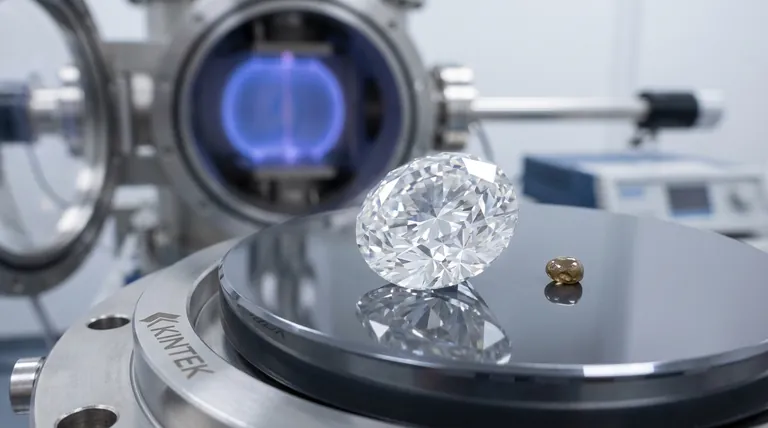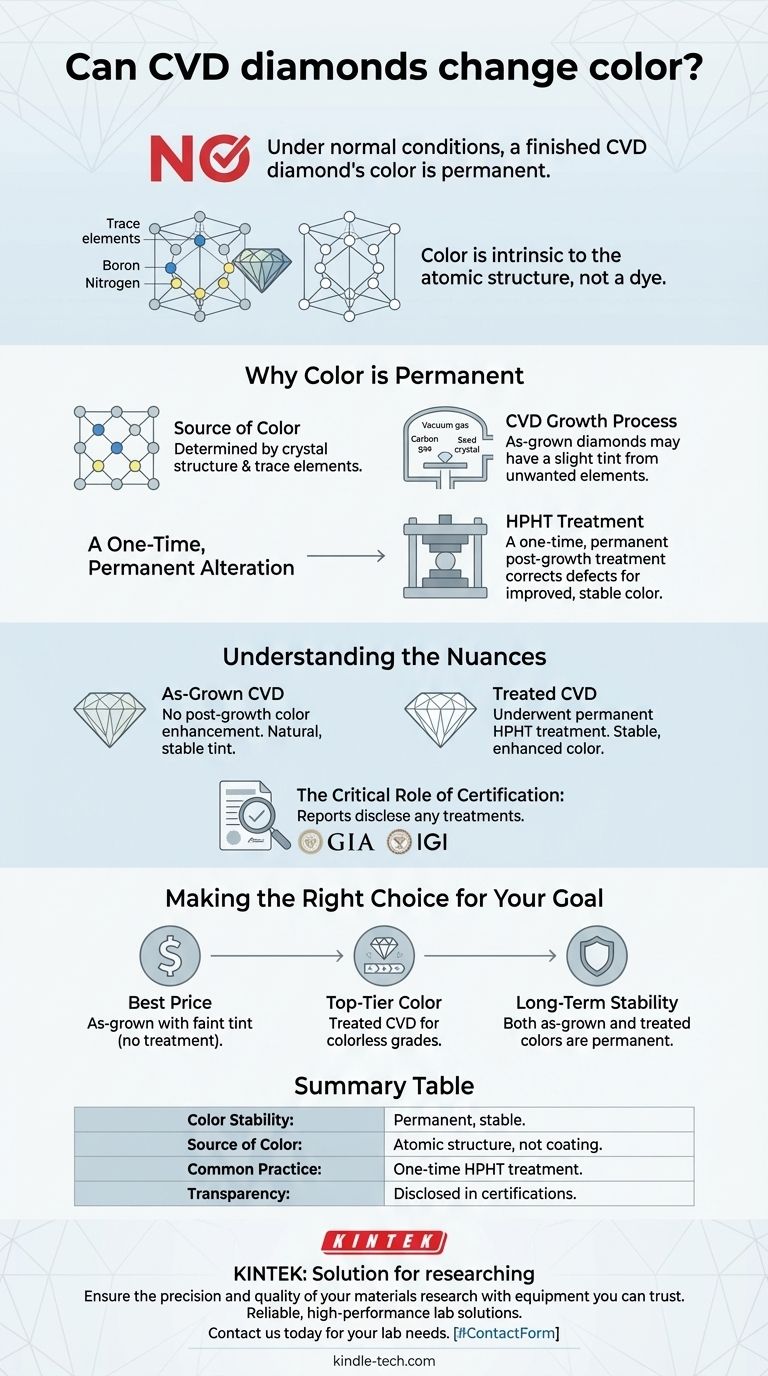Under normal conditions, no. A finished CVD (Chemical Vapor Deposition) diamond will not change color over time. Its color is a permanent characteristic of its atomic structure, making it just as stable and resilient as a mined diamond. The color you see when you purchase the stone is the color it will retain for a lifetime.
The core issue is not whether a finished CVD diamond can spontaneously change color—it cannot. The confusion arises because many CVD diamonds undergo a one-time, permanent color enhancement before they are sold to improve their appearance from their initial "as-grown" state.

Why a Diamond's Color Is Permanent
The Source of Color
A diamond's color, whether natural or lab-grown, is determined by its crystal structure and the presence of trace elements. It is not a dye or a coating.
Perfectly structured diamonds with no impurities are colorless. Different elements trapped during formation cause color variations, such as nitrogen causing yellow tints or boron creating blue hues.
The CVD Growth Process
CVD diamonds are grown by introducing carbon-rich gases into a vacuum chamber, causing carbon atoms to deposit onto a diamond seed crystal, layer by layer.
During this process, unwanted trace elements like nitrogen can sometimes be incorporated, or structural irregularities can form. This often results in the "as-grown" CVD diamond having a slight brownish or greyish tint.
A One-Time, Permanent Alteration
To eliminate these unwanted tints, many CVD diamonds undergo a one-time post-growth treatment. This typically involves a High-Pressure, High-Temperature (HPHT) process.
This treatment is not a temporary fix. It permanently alters the diamond's crystal lattice, correcting the defects that cause the undesirable color. The resulting improved color is stable and will not fade or revert.
Understanding the Nuances
"As-Grown" vs. Treated CVD Diamonds
You may encounter terms like "as-grown" or "treated." An "as-grown" CVD diamond has not undergone any post-growth color enhancement. A "treated" diamond has, which is a very common practice to achieve higher color grades.
The key is that this treatment happens once, in a lab, under extreme conditions. It is not something that can happen while being worn.
The Critical Role of Certification
Reputable gemological labs like the GIA (Gemological Institute of America) or IGI (International Gemological Institute) analyze lab-grown diamonds.
Their reports will clearly state if the diamond is lab-grown and will disclose any post-growth treatments used to alter its color. This disclosure gives you complete transparency about the stone's history.
Making the Right Choice for Your Goal
When buying a CVD diamond, the color it has is the color it will keep. The decision comes down to understanding what you are buying and ensuring it matches your priorities.
- If your primary focus is the best possible price: An "as-grown" CVD diamond with a faint tint (and no treatment) might offer significant value, provided you are happy with its appearance.
- If your primary focus is top-tier color: You will likely be choosing a CVD diamond that has undergone post-growth treatment to achieve a colorless or near-colorless grade. Always confirm this by reviewing the official grading report.
- If your primary focus is long-term stability: Rest assured that whether "as-grown" or treated, the final color of any certified CVD diamond is permanent.
By checking the diamond's certification, you can purchase with confidence, knowing its characteristics are stable and fully disclosed.
Summary Table:
| Aspect | Key Takeaway |
|---|---|
| Color Stability | The color of a finished CVD diamond is permanent and will not change over time. |
| Source of Color | Color is determined by the diamond's atomic structure and trace elements, not a surface coating. |
| Common Practice | Many CVD diamonds undergo a one-time HPHT treatment to improve color from their "as-grown" state. |
| Transparency | Reputable certifications (GIA, IGI) clearly disclose any post-growth treatments. |
Ensure the precision and quality of your materials research with equipment you can trust.
Just as a certified CVD diamond offers permanent stability, KINTEK provides reliable, high-performance lab equipment and consumables that deliver consistent, accurate results for all your laboratory needs. Our expertise supports researchers in achieving their goals with confidence.
Contact us today to find the perfect solution for your lab. #ContactForm
Visual Guide

Related Products
- Custom CVD Diamond Coating for Lab Applications
- CVD Diamond Domes for Industrial and Scientific Applications
- Cylindrical Resonator MPCVD Machine System Reactor for Microwave Plasma Chemical Vapor Deposition and Lab Diamond Growth
- CVD Diamond Cutting Tool Blanks for Precision Machining
- CVD Diamond Optical Windows for Lab Applications
People Also Ask
- What is diamond coating film? A Thin Layer of Diamond for Extreme Performance
- Is diamond coating worth it? Maximize Component Life and Performance
- What is the process of CVD diamond coating? Grow a Superior, Chemically-Bonded Diamond Layer
- What is CVD diamond coating? Grow a Super-Hard, High-Performance Diamond Layer
- What are diamond coated films? Enhance Materials with Super-Hard, Transparent Layers



















